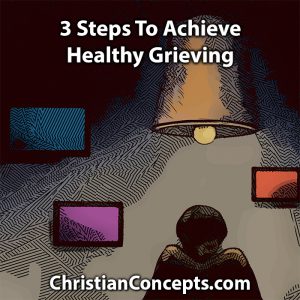Grieving allows the healthy emotional resolution of a disturbing event–especially when the event seems impossible to accept.
All grieving is temporary. It is time-limited. It has a beginning and an end. Yet, it is possible to become stuck in grief. This happens because we are unable or unwilling to face the reality of a difficult event (or multiple events).
When the event seems to be too much for you, how can you become free again? To be stuck in grief is to be stuck in time. Events happen in time. Memories of those events are reminders of what you’ve been through.
1) The Past Helps You Achieve Healthy Grieving
To move forward in grief, you must first move backward in time. A substantial part of the grieving process involves working with your memories. There is a lot you can do (and perhaps need to do) in order to fully process a memory (see additional posts about this at the end of this post). But if your goal is to become unstuck, the first question to ask is: What did the event cost you?
When you attempt you answer this simple question, you have little choice but to re-enter the memory and recognize the true nature of your loss. What changed? How did the event affect your life?
You might not be willing to relive the event, but maybe you are willing to look at how your life changed for the worse because of it? After a negative event, you are never the same again. What did the event cost you?
2) The Present Helps You Achieve Healthy Grieving
After you have a clear picture of what the event cost you way back in the past somewhere, the next step is to see how the cost carries forward in your life. What is the event still costing you today?
This question helps you see how well you’ve managed the cost over time. How has the cost changed? Is it worse, the same, or improved? It can be a shock to realize how much an event from years ago is still influencing you today.
Have you been ignoring the cost or actively managing it? To complete this second step, you need to know the overall impact of the event on your life. What additional opportunities have you lost since the original event?
3) The Future Helps You Achieve Healthy Grieving
If you’ve completed steps 1 and 2, you’ve accomplished a lot. However, you can still be stuck if you haven’t allowed the event to propel you forward in some new, ground-breaking direction.
In step 1, you recognize you’re in a hole. In step 2, you learn your resistance to getting out. Step 3 pulls everything together: you determine to not only get out of the hole but build and climb a ladder that takes you higher than you have ever been. What do you want to do about the event now?
Your grieving and recovery are not fully done until you look beyond your loss to how you can change for the better. For example, if you lose a job you loved, you probably won’t get the job back, but you can focus on what you love even more which could lead to a different but better job. Or, you might even decide to become a job coach to help others with their job losses.
Another example is the loss of a loved one. You can struggle that you will never see the person again. That’s step 1 and 2. Step 3 is figuring out how your loss is changing you and how you want to make a difference because of who you are.
In step 3, you shift your focus from what you can’t do to what you can do. You can’t bring your loved one back, but, because of your loss, you can more fully realize what is most important to you and to God.
God wants you to make it through your grieving, so you can see what else is possible in your life. Grieving is necessary, but it’s not the end. You can grieve your losses, discover the cost, and find a way forward that brings positive change to yourself and others.
Image by kirillslov from Pixabay
Read more about healing memories.
Read more about growing through change as God makes all things new



